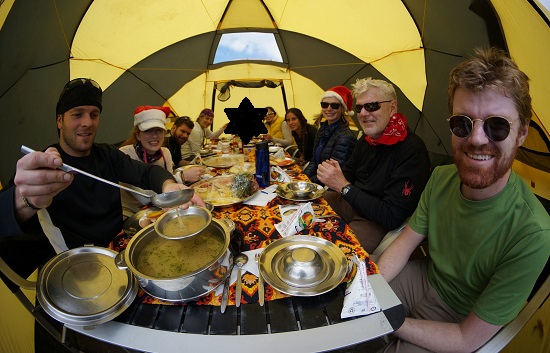Lunch
While Climbing the Kilimanjaro Mountain, lunch is usually prepared after the breakfast and being carried by the climbers on their daypack. Hence it is not a hot lunch, the lunch normally consist of a Sandwiches, boiled egg, a piece of fruit, and some tea carried by the mountain guide in a flask. The national park authority, for the reason of the environment protection, tries to stop making cooked lunches along the trail.
Evening tea and dinner
Up on reaching the camp at the end of the day, climbers will be served with an afternoon tea that goes with Peanuts, biscuits and salted popcorn. Then dinner which usually begins with a soup followed by a main course which includes meat or chicken, some cabbage, vegetable sauce, and pasta or rice
Tipping of the Kilimanjaro Guides, Porters and others
It is a custom to give tips to the Kilimanjaro Mountain Crew (Guide, cooks & Porters), this is done upon the completion of your climb. On making the decision on how much to tip, the success summit should not be one of the factors, but consider how well did the crew serves you while you were on the Mountain. The standard amount for tipping are as follows; 20$/day for the guide, 12$/day for assistant guide, 12$/day for the cooks and 6$/day for the porters, the amount are recommended by the Kilimanjaro Porters Assistance Project (KIPAP), which is the organization that ensures fair treatment of the porters and working for the improvement of the working environment for those who works in the Kilimanjaro Mountain.
Moreover Porter can be in the division of waiters, toilet porters and the summit porter, have an extra responsibilities than the original one of carrying luggage, hence they are to be given additional in tipping for providing such service, but the amount to add in not recommended but it is up on the climber on how much they should add.
On climbing the Kilimanjaro Mountain, other than the Private climb, there is also a group climb, whereby the description below show the figure amount with the group Climb and type of route with the number of climbing days.
6 Days Route (Group of 15 Climbers)
1 chief Guide, 130$ -150$
6 Assistant guides, 80$- 90$ per each
2 Cooks 80$- 90$ per each
47 porter $40-50$ per each
56Total Staffs $2650-$3220 (Each Client should expect to tip $175 to $220)
7 Days Route (Group of 15 Climbers)
- 1 chief Guide, 130$ -150$
- 6 Assistant guides, 80$- 90$ per each
- 2 Cooks 80$- 90$ per each
- 47 porter $40-50$ per each
- 56Total Staffs $2650-$3220 (Each Client should expect to tip $175 to $220)
8 Days Route (Group of 15Climbers)
- 1 chief Guide, 130$ -150$
- 6 Assistant guides, 80$- 90$ per each
- 2 Cooks 80$- 90$ per each
- 47 porter $40-50$ per each
- 56Total Staffs $2650-$3220 (Each Client should expect to tip $175 to $220)
However there are group with less than 16 whereby when the climbers are in full of 12 to 16, they should expect to tip on lower than, while those in a group of few people let say 4 to 6 people should expect to tip on higher end of the above ranges, and the small group of 1 to 3 people should expect to tip higher than the above ranges. The difference in tipping ranges is due to the number of mountain crew needed in a group.

